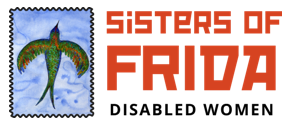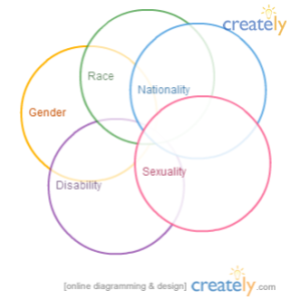

Bringing disabled women together, mobilising
and sharing through lived experiences
What Is “Intersectional” Anyway?
Many thanks to Emma @pseudodeviant for letting us repost this blog.

Emma with SoF 2012 at MWR
I imagine that if you are reading this you identify either as a feminist, a disabled person* or as an ally of feminists and/or disabled people and you might have heard the term “intersectional” or “intersectionality” used when talking about peoples rights. It might sound a bit academic, but the principle is fairly simple and extremely important so I’m going to attempt to explain it in this post.
In a nutshell:
People are oppressed for a variety of different reasons such as disability, gender, culture, sexuality & race. There is a lot of overlap between these oppressions; we call the areas of overlap intersections. Someone who campaigns for disabled peoples’ rights in an intersectional way is aware that there are lots of disabled people who are not heterosexual, cisgendered, white men and that they will probably be living with more than one kind of oppression. Many people, myself included, believe that it is very important to remember intersecting oppressions to make sure that our campaigning is as inclusive of everybody’s needs as possible.

A very simple venn diagram showing some intersecting circles of oppression including gender, disability, sexuality, nationality & race.
If you are a disabled person or an ally to disabled people I assume you will be no stranger to the idea that our society is, at it’s core, disablist. The majority of people in positions of power are non-disabled and this is in a large part because disabled people are still routinely silenced, dismissed, ignored or refused access to the necessary tools to be able to communicate meaningfully. They are frequently excluded from politics, from decision making and from society as a whole because of damaging and deep seated idea’s about what disability is or means. It results in a large gap in pay, employment prospects, education, access to health care and access to independent living between disabled and non-disabled people. The power gap between disabled and non-disabled people is frequently abused and results in disability related hate-crime, abuse & harassment whilst the successful prosecution of such crimes remains woefully low.
If you are a feminist or an ally to feminists then I assume you will be no stranger to the concept that our society is still very sexist. The majority of people in positions of power are male and they decide what media we consume, what policies we follow and how our laws are applied. Sexist stereotypes brand men as strong, powerful, aggressive, logical and confident and women as weak, passive, caring, guided by emotion and small and they have damaging effects on men & women alike who do not fit those very constraining moulds. There is a large gap in pay, caring expectations, attainment and employment & educational choices between women and men. The power gap between men and women is frequently abused and results in statistics like 1 in 4 women being domestically abused in their lifetime, 1 in 5 women being sexually assaulted or stalked whilst the chances of getting these crimes taken to court is still low.
I would hope that it doesn’t come as a shock when I now say that as well as people being discriminated against because of their gender/gender identity (or perceived gender) or because they are disabled (or perceived to be disabled) are also discriminated against in remarkably similar ways because of their race (or perceived race), age (or perceived age), sexuality (or perceived sexuality) and beliefs (or perceived beliefs).
We can also see that where there is an overlap of identities (or an intersection of identities) people face extra discrimination. I will take the example of disabled women quickly to illustrate this point. Disabled men get paid on average 11% less than similarly qualified non-disabled men doing the same job. Disabled women get paid 22% less than disabled men when doing the same job**. They effectively take one pay cut because of disability, then another because of gender. Disabled women are more than twice as likely to experience domestic/intimate abuse than non-disabled women.
When human/civil rights campaigners talk about taking an intersectional approach they are talking about remembering that there are other forms of oppression active and that these need to be taken into account. It is important to remember that when talking about women’s rights that many of those women will also be one or more of the following; disabled, working-class, black or minority ethnic (BME), lesbian, gay, bisexual, trans*, intersex, queer (LGBTIQ) and/or hold cultural & religious beliefs that differ to the ‘norm’. When women’s rights campaigning ignores those areas it is complicit in further marginalising these women on the basis of their other characteristics.
Intersectionality is not about who wins the “most oppressed” award, nor is it about derailing or silencing conversations. The joy of intersectionality is that it raises questions for everyone and widens the scope of conversation, debate and dialogue. It is a tool which can be used to improve campaigns, make for a far more inclusive environment and to remind people not to assume that everyone has an equal and shared background. I don’t know about you but I personally don’t want to see advances in feminism that set LGBTIQ people back in their fight for equality and nor do I want to see advances in disability rights that ignore the reality of sexism that the people it represents experience.
I’m going to stop there. Hopefully that has given a basic introduction to the concept and hopefully it will have made some sense.
* In this post when I talk about disability I am talking about people who have an impairment and are disabled by a society that oppresses them as a result. My definition of disability includes long term sickness/illness and conditions like HIV.
** See Longhi,S. and Platt, L. 2008, Pay and equalities areas. Research report 9. Equality and Human Rights Commission. Also covers pay gaps with regards to other protected characteristics.

Intelligent commentary and very inclusive